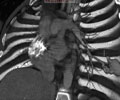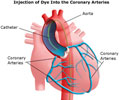Coronary angiography is a procedure that uses a special dye (contrast material) and x-rays to see how blood flows through your heart.
How the test is performed
Coronary angiography is usually done in conjunction with cardiac catheterization. Before the test starts, you will be given a mild sedative to help you relax. An area of your body, usually the arm or groin, is cleaned and numbed with a local numbing medicine (anesthetic). A thin hollow tube called a catheter is placed through an artery and carefully moved up into the heart. X-ray images help the doctor position the catheter.
The surgery will be performed using general or spinal anesthesia. The orthopedic surgeon makes an surgical cut, often over the buttocks, to expose the hip joint. The head of the thigh bone is removed and removed. Then, the hip socket is cleaned out and a tool called a reamer removes all of the remaining cartilage and arthritic bone.
Once the catheter is in place, dye (contrast material) is injected into catheter. X-ray images are taken to see how the dye moves through the artery. The dye helps highlight any blockages in blood flow.
How to Prepare for the Test?
You should not eat or drink anything for 8 hours before the test starts. You may need to stay in the hospital the night before the test. Otherwise, you will check in to the hospital the morning of the test. You will wear a hospital gown. You must sign a consent form before the test. Your health care provider will explain the procedure and its risks.
Tell your doctor if you are allergic to seafood, if you have had a bad reaction to contrast material in the past, if you are taking Viagra, or if you might be pregnant.
How you will feel?
The procedure may last from 1 to several hours. You are awake during the test. You may feel some pressure at the site where the catheter is inserted. Occasionally, a flushing sensation occurs after the dye is injected. After the test, the catheter is removed. You might feel a firm pressure at the insertion site, used to prevent bleeding. If the catheter is placed in your groin, you will usually be asked to lie flat on your back for a few hours after the test to avoid bleeding. This may cause some mild back discomfort.
Why the Test is performed?
Coronary angiography is done to find a blockage in the coronary arteries, which can lead to heart attack. It may be done if you have unstable angina, atypical chest pain, aortic stenosis, or unexplained heart failure.
Results
There is a normal supply of blood to the heart and no blockages. An abnormal result may mean you have a blocked artery. The test can show how many coronary arteries are blocked, where they are blocked, and the severity of the blockage(s).



